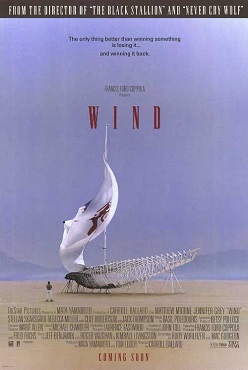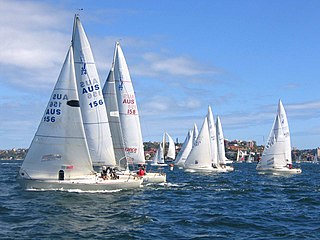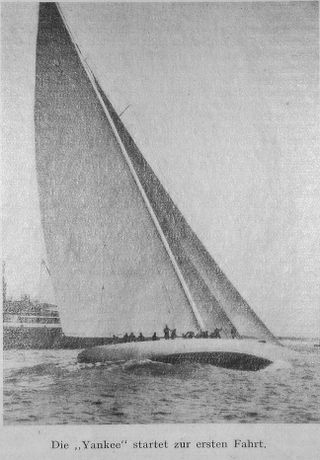
Yacht racing is a sailing sport involving sailing yachts and larger sailboats, as distinguished from dinghy racing, which involves open boats. It is composed of multiple yachts, in direct competition, racing around a course marked by buoys or other fixed navigational devices or racing longer distances across open water from point-to-point. It can involve a series of races with buoy racing or multiple legs when point-to-point racing.

The America's Cup, informally known as the Auld Mug, is a trophy awarded in the sport of sailing. It is the oldest international competition still operating in any sport. America's Cup match races are held between two sailing yachts: one from the yacht club that currently holds the trophy and the other from the yacht club that is challenging for the cup. Matches are held several years apart on dates agreed between the defender and the challenger. There is no fixed schedule, but the races have generally been held every three to four years. The most recent America's Cup match took place in March 2021.

A J-Class yacht is a single-masted racing yacht built to the specifications of Nathanael Herreshoff's Universal Rule. The J-Class are considered the peak racers of the era when the Universal Rule determined eligibility in the America's Cup.

Reliance was the 1903 America's Cup defender designed by Nat Herreshoff.

Wind is a 1992 film directed by Carroll Ballard and starring Matthew Modine, Jennifer Grey and Cliff Robertson.
Luna Rossa Prada Pirelli, originally named Prada Challenge, then Luna Rossa Challenge, is an Italian sailboat racing syndicate first created to compete for the 2000 America's Cup. It won the Louis Vuitton Cup on their first attempt in 2000, but then lost the America's Cup match against the defending champion team, Team New Zealand.
New Zealand "Kiwi Magic" was the America's Cup challenge boat sailed by Chris Dickson in the Louis Vuitton Cup Challenger series held in Gage Roads off Fremantle, Australia during the summer months of 1986 through 1987. She was New Zealand's first America's Cup entry and was the premier boat in the New Zealand Challenge syndicate.
The 1987 Defender Selection Series was raced between four syndicates competing for the right to represent the Royal Perth Yacht Club as the defender of the America's Cup. Kookaburra III won the series and advanced to the 1987 America's Cup. However, they failed to defend the cup from the challenge of Stars & Stripes 87.
New Zealand Challenge was a sailing team funded by Michael Fay that challenged for the America's Cup three times between 1987 and 1992. New Zealand Challenge was the first team from New Zealand to enter the competition.

Endeavour is a J-class yacht built for the 1934 America's Cup by Camper and Nicholson in Gosport, England. She was built for Thomas Sopwith who used his aviation design expertise to ensure the yacht was the most advanced of its day with a steel hull and mast. She was 130-foot (40 m) and launched in 1934 and won many races in her first season including against the J's Velsheda and Shamrock V. She failed in her America's Cup challenge against the American defender Rainbow but came closer to lifting the cup than any other until Australia II succeeded in 1983.

The sport of sailing involves a variety of competitive sailing formats that are sanctioned through various sailing federations and yacht clubs. Racing disciplines include matches within a fleet of sailing craft, between a pair thereof or among teams. Additionally, there are specialized competitions that include setting speed records. Racing formats include both closed courses and point-to-point contests; they may be in sheltered waters, coast-wise or on the open ocean. Most competitions are held within defined classes or ratings that either entail one type of sailing craft to ensure a contest primarily of skill or rating the sailing craft to create classifications or handicaps.

Charles Ernest Nicholson was a British yacht designer.

Shamrock V was the first British yacht to be built to the new J-Class rule. She was commissioned by Sir Thomas Lipton for his fifth America's Cup challenge. Although refitted several times, Shamrock is the only original J-class never to have fallen into dereliction.
Enterprise was a 1930 yacht of the J Class and successful defender of the 1930 America's Cup for the New York Yacht Club. It was ordered by a syndicate headed by Vice-Commodore Winthrop Aldrich, designed by Starling Burgess, and built by Herreshoff Manufacturing Company.
Whirlwind was a 1930 yacht of the J Class built as a contender for the New York Yacht Club's defence of the 1930 America's Cup. She was ordered by a syndicate headed by Landon Ketchum Thorne, designed by Lewis Francis Herreshoff, and built by Lawley & Son. Whirlwind was unsuccessful in her bid to become the Cup defender, an honor that went to Enterprise. She never sailed again after the Cup races, and was scrapped in 1935.

Yankee was a 1930 yacht of the J Class built as a contender for the New York Yacht Club's defence of the 1930 America's Cup. She was ordered by a syndicate from the Eastern Yacht Club of Boston, organized by John Silsbee Lawrence, designed by Frank Cabot Paine, and built by Lawley & Son. Whirlwind was unsuccessful in her bid to become the Cup defender, an honor that went to Enterprise. With modifications, she took part in the trials for the 1934 America's Cup. She was eventually taken to the United Kingdom by a new owner in 1935 and was scrapped in 1941.
Weetamoe was a 1930 yacht of the J Class built as a contender for the New York Yacht Club's defence of the 1930 America's Cup. She was ordered by a syndicate headed by Junius Morgan, designed by Clinton Hoadley Crane, and built by Herreshoff Manufacturing Company. Weetamoe was unsuccessful in her bid to become the Cup defender, an honor that went to Enterprise. She continued to sail for a few years afterwards, before being scrapped in 1937.
Camper and Nicholson was a yacht design and manufacturing company based in Gosport, England, for over two hundred years, constructing many significant vessels, such as Gipsy Moth IV and Prince Philip's yacht Bloodhound. Its customers included Thomas Sopwith, William Kissam Vanderbilt II and George Spencer-Churchill, 6th Duke of Marlborough. Its yachts competed in The America's Cup, The Fastnet Race, the Olympics, the Ocean Race and many other yacht races.
The 1930 America's Cup was the 14th challenge for the Cup. It took place in Newport and consisted of a series of races between the defender Enterprise, entered by a syndicate of New York Yacht Club members headed by Winthrop Aldrich, and Shamrock V, the fifth in Sir Thomas Lipton's line of Cup challengers.
The 1937 America's Cup was the 16th challenge for the Cup. It took place in Newport and consisted of a series of races between the defender Ranger, entered Harold S. Vanderbilt, and Endeavour II, the second in Sir Thomas Sopwith's line of Cup challengers.









